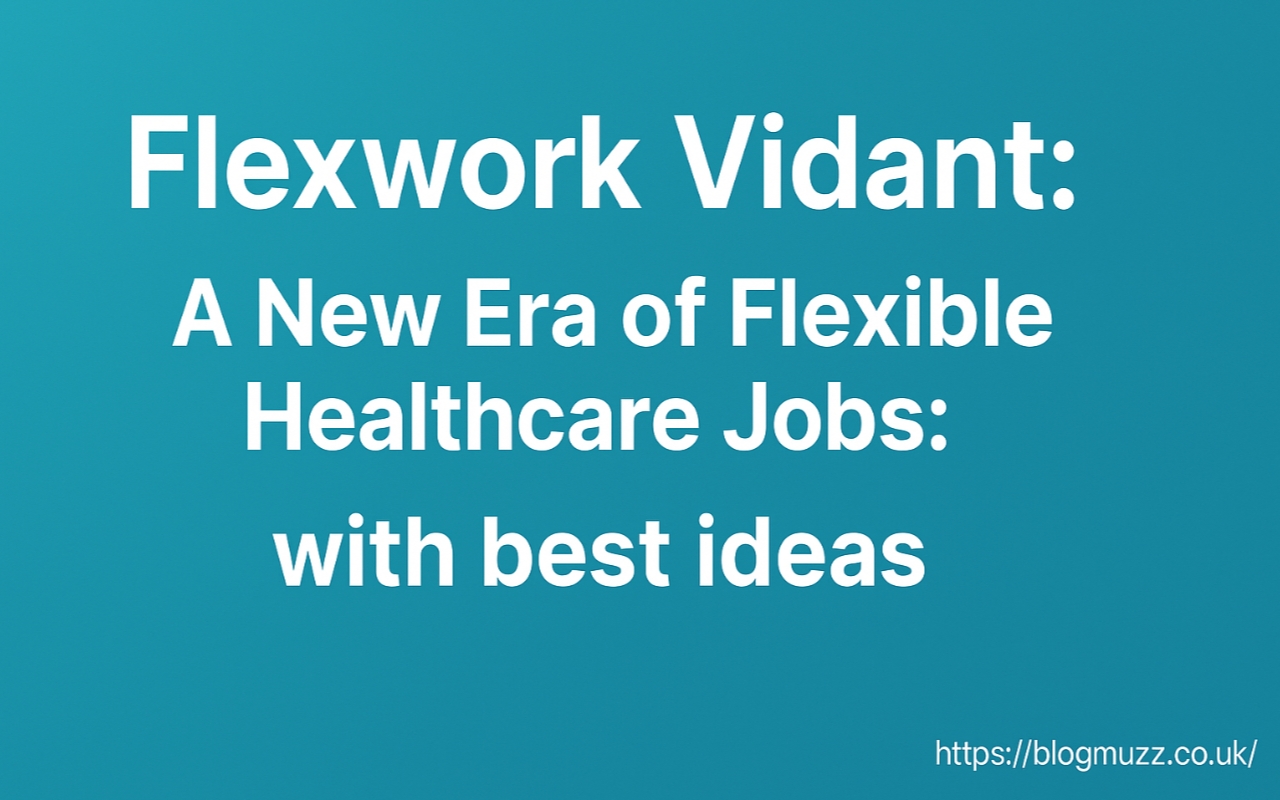Introduction to Flexwork Vidant
The healthcare industry is evolving rapidly, and with it comes the need for new approaches to work-life balance, scheduling, and workforce management. Flexwork Vidant is one such initiative designed to provide healthcare professionals with greater flexibility in how they work while still ensuring patient care standards remain high. In today’s fast-paced and demanding medical environment, burnout, stress, and staffing shortages have become major concerns. Flexwork Vidant is positioned as a solution to address these challenges by offering healthcare workers flexible scheduling options, part-time roles, and innovative staffing models that prioritize both employee well-being and patient outcomes.
What Is Flexwork Vidant?
Flexwork Vidant is a staffing and workforce solution implemented by Vidant Health, a healthcare system based in North Carolina. The concept revolves around creating a flexible employment structure that allows nurses, physicians, and allied health professionals to choose work arrangements that suit their personal lives while contributing effectively to the healthcare system. Unlike traditional full-time, rigid scheduling models, Flexwork Vidant emphasizes autonomy, adaptability, and job satisfaction. By offering varied shifts, short-term contracts, and remote healthcare options where possible, Flexwork Vidant helps employees stay engaged, motivated, and less prone to burnout.
The Growing Demand for Flexible Healthcare Jobs
Healthcare jobs have traditionally been known for long hours, unpredictable shifts, and the physical and emotional toll they can take on workers. As the demand for healthcare services continues to grow due to aging populations, increased chronic illnesses, and ongoing public health concerns, the workforce is under more pressure than ever before. Flexible work models like Flexwork Vidant meet the growing demand for adaptable schedules that allow healthcare workers to balance their professional responsibilities with family obligations, continuing education, and personal well-being. This demand is especially pronounced among nurses, who often face high turnover rates due to stress and inflexible schedules.
How Flexwork Vidant Supports Work-Life Balance
One of the most significant advantages of Flexwork Vidant is its strong emphasis on work-life balance. Healthcare workers who participate in this program can customize their schedules to align with their personal needs. For example, a nurse who is also a parent may choose shifts that allow them to spend time with their children, while another may prefer evening or weekend work to accommodate higher education or a second career. This flexibility reduces stress and makes it easier for employees to manage both professional and personal responsibilities. In the long term, improved work-life balance leads to higher job satisfaction, better mental health, and increased retention rates in healthcare organizations.
Benefits of Flexwork Vidant for Healthcare Workers
Healthcare professionals enrolled in Flexwork Vidant enjoy a wide range of benefits. The most obvious is the ability to choose when and how they work, but the advantages go far deeper. Flexible scheduling helps reduce burnout, which is one of the leading causes of staff turnover in healthcare. It also allows workers to pursue career development opportunities, such as specialized training or higher education, without sacrificing income. Additionally, flexible work models can improve employee engagement by giving staff more control over their careers. For healthcare workers who are nearing retirement, Flexwork Vidant provides an option to scale back their hours without leaving the workforce entirely, which helps preserve their expertise within the system.
Benefits of Flexwork Vidant for Healthcare Organizations
Healthcare organizations also reap significant benefits from implementing Flexwork Vidant. One of the biggest challenges in the industry is maintaining adequate staffing levels, particularly during peak demand periods. Flexwork Vidant provides a pool of professionals who are available on flexible terms, which helps reduce the impact of staffing shortages. Organizations can also reduce turnover by offering more supportive and adaptable employment options. Furthermore, flexible work models often attract top talent who might otherwise avoid traditional healthcare jobs due to rigid schedules. This can give hospitals and clinics a competitive edge in recruitment while improving patient care outcomes through better-staffed facilities.
Technology’s Role in Flexwork Vidant
The success of Flexwork Vidant depends heavily on modern technology. Advanced scheduling software, digital communication tools, and telehealth platforms make it possible for healthcare professionals to coordinate their shifts, access patient information remotely, and deliver virtual care when necessary. Scheduling systems can automatically match workers to shifts based on their availability, skills, and preferences, reducing administrative burden and ensuring more efficient use of human resources. In addition, telemedicine capabilities allow certain healthcare roles, such as consultations or follow-up care, to be performed remotely, which expands the definition of flexible work in the healthcare industry.
Challenges in Implementing Flexwork Vidant
While Flexwork Vidant offers numerous benefits, it also comes with challenges that healthcare organizations must address. Coordinating flexible schedules can be complex, particularly in high-demand specialties where staffing needs are critical around the clock. There is also the risk of communication gaps when multiple staff members rotate through patient care duties. Organizations must ensure that proper handoff procedures, record-keeping, and team collaboration tools are in place to maintain high-quality care. Additionally, not all roles within healthcare are easily adaptable to flexible schedules, which can create disparities between different employee groups. Overcoming these challenges requires strong leadership, robust technological support, and a culture that values flexibility while prioritizing patient safety.
The Future of Healthcare Work and Flexwork Vidant
The introduction of Flexwork Vidant is just one step toward a broader transformation of healthcare employment models. As more healthcare organizations adopt flexible scheduling practices, the industry as a whole may shift toward prioritizing employee well-being alongside patient outcomes. The COVID-19 pandemic highlighted the need for adaptability in healthcare, and initiatives like Flexwork Vidant reflect lessons learned during that time. In the future, we may see greater integration of remote healthcare roles, gig-style healthcare employment, and even cross-organization staffing pools that allow workers to share their skills across multiple facilities. Flexwork Vidant is at the forefront of this trend, paving the way for a more sustainable, supportive, and resilient healthcare workforce.
Conclusion
Flexwork Vidant represents a significant shift in how healthcare employment is structured, moving away from rigid, traditional models toward a system that prioritizes flexibility, autonomy, and well-being. For healthcare workers, it provides a path to better work-life balance, reduced burnout, and improved career satisfaction. For organizations, it helps solve staffing challenges, improve retention, and attract top talent. Though challenges remain in implementation, the long-term benefits of Flexwork Vidant suggest that this model will play a vital role in shaping the future of healthcare work. As the industry continues to evolve, embracing flexibility may prove essential to sustaining both the workforce and the quality of patient care.



